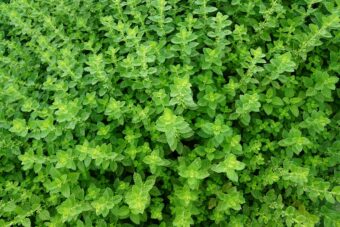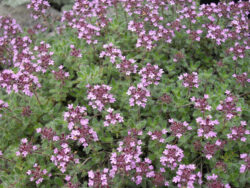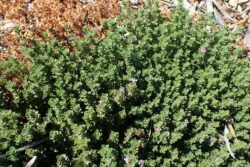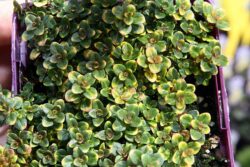In this article, we will discuss how to grow Thymus (Thyme) in containers. You will discover that it is much more than a culinary herb, as the scent is delightful and the leaves are often beautifully variegated and colourful. The flowers are a magnet to wildlife, whilst the edible leaves can be used fresh or dried. It can be used to flavour soups, fish dishes, meat dishes, stuffings and vegetables dishes.

It is also a drought-tolerant plant once established and will make a great addition to a sunny patio. A plant that not only looks attractive, smells attractive but has a multitude of uses in the kitchen. A versatile plant for the container garden.
The flowers that are produced are small and often come in pinks and mauves that often complement the leaves. One of the unique selling points of thyme is that the shrub tends to be short, only growing up to 30cm high and therefore making it a suitable plant for containers.
HOW TO GROW THYMUS IN CONTAINERS
You have two options for how you grow thyme in containers. You can either grow from named-variety thyme from seed or you can buy garden-ready plants. The latter you will be limited to what varieties can be grown and what is available online or in garden centres.
HOW TO GROW THYME FROM SEED
In early spring, fill a 7.5cm diameter pot with seed sowing compost and lightly scatter some seeds over the surface. On top of this, lightly sieve some more compost to cover the seeds and water gently. It is then best to cover the pot with Clingfilm to increase the humidity and to aid in the seed germination.

Place the pots on a heat mat or in a propagator and wait for the seeds to germinate. Once the seedling is large enough to handle, prick them out and then plant onto individual 7.5cm pots full of multipurpose compost to grow on. Allow the plant to grow to a decent size and when it is ready in late May, it can be planted out in a container once frosts have passed.
HOW TO PLANT READY BOUGHT THYME PLANTS
At this stage, you can plant the ready bought Thyme plants exactly the same way you would plant home-reared thyme plants.
In a 15cm diameter container that has an adequate amount of drainage holes, add a 2.5cm layer of gravel to help ensure that excess moisture drains away. On top of this add a mix of 70% by volume of multipurpose compost with 30% by volume of horticultural grit.
Dig a hole that is slightly bigger than the root ball it came in the original container. Place the plant in the hole at the same level it came in the original container-no deeper or no shallower. Backfill with the growing media and fill any gaps with more potting mix. Firm the plant in and water well.

Place a layer of grit around the plant in the container to protect the leaves from touching bare soil. Place the plant in a rain shadow to prevent excess water from rotting the roots of the plant. The container should be placed where it will get as much light as possible, a south-facing patio is ideal.
Only water when the compost is dry and the plant is obviously struggling. Once established the plants are tolerant of drought but until then you will need to water when required.
In terms of pruning, it is best to crop them in shape after it has flowered by clipping them with shears. Any leaves that have fallen should be removed as soon as possible to prevent any infections from being harboured.
Every early spring gives an annual feed of slow-release fertilizer to help it grow through the growing season.
PESTS AND DISEASES
The plant tends to be relative pests and disease-free. If you are unlucky, you may suffer from mealybugs that will occupy leaf joints or under loose bark. The best way to treat them is by using a suitable systemic insecticide that will work to deal with this pest.
They can be attacked by rosemary beetles which are best dealt with by hand picking and crushing them underfoot.
VARIETIES TO GROW
You have plenty of choice as to what variety of thyme to grow and some of the best are:

‘Anne Hall’ has mid-green leaves and in summer pale pink flowers.
‘Bertram Anderson’ has golden green-yellow leaves and in summer pink flowers are produced.
Thymus herbia-barona (Caraway Thyme) has lemony caraway scented green leaves and in summer pink flowers are produced.
Thymus ciliatus (Cillicum Thyme) has bright vivid green leaves where in summer they are covered with a mass of pink flowers.
‘Golden King’ has lemon-scented, variegated yellow leaves and in summer pink flowers are produced.
‘Silver Prize’ is another variety that has green leaves that are silver-edged. In summer, pale pink flowers appear that complement the plant.
Thymus serpyllum ‘Pink Chintz’ is a sub-shrub that forms a carpet of tiny, rounded slightly woolly, dark green leaves. In summer small, salmon-pink flowers are produced.
‘Doone Valley’ is creeping thyme with fragrant, dark olive-green leaves with yellow variegation. During the summer months, lavender-pink flowers appear that complete the look.
‘Archer’s Gold’ is lemon-scented thyme that has golden yellow-green leaves and in summer pink flowers appear.
With variegated thyme, you will need to watch out for reversions, as this can spoil their look. You will need to remove them as soon as they are seen.
CONCLUSIONS
In this article, we have discussed how to grow Thymus in containers. If you want a plant that not only looks good but also smells good and tastes good, then this is a plant for you. It is a plant that does not require much in the way of care but has many varieties available. One must is that in particularly in winter that the roots are kept dry, otherwise it will rot and you will lose your plant.
A plant that is small and colourful and suitable for your container patio display. If you have any questions or comments that you wish to make on growing thyme in containers, please do so in the comment box below.
Happy Thymus growing.
